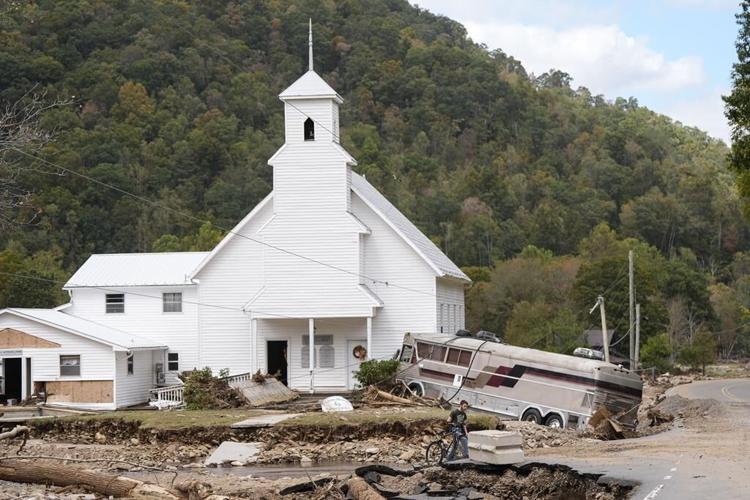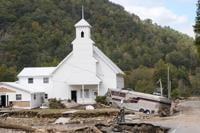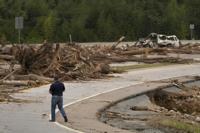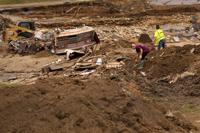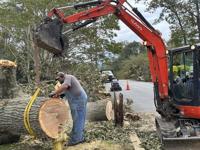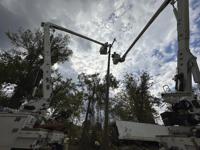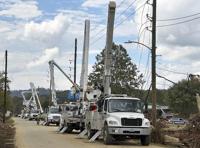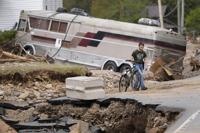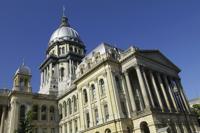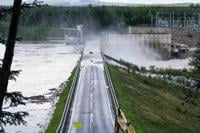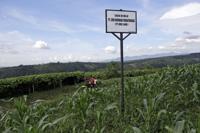ASHEVILLE, N.C. (AP) — The weary and worn residents of Julianne Johnson's neighborhood in Asheville have been getting by without electricity since Hurricane Helene tore through the Southeast last week and upended their lives. They've been cooking on propane stoves and using dry erase boards to keep up with local happenings while wondering when the lights would come back on.
Johnson, who has a 5-year-old son and works for a land conservation group, received a text from Duke Energy promising her power would be restored by Friday night. But as of midday, utility poles and wires were still draped at odd angles across the streets, pulled down by mangled trees.
“I have no idea what’s next,” said Johnson, whose family does have some power thanks to a generator. “Just the breadth of this over the whole region, it’s kind of amazing.”
She and her neighbors have been taking care of each other since Helene came ashore Sept. 26 as a and carved a path of destruction as it moved northward from Florida, in six states, including at least 72 in Buncombe County, which includes Asheville. Block captains set out whiteboards with information about who can provide first aid and where to get tools repaired.
Nearly 700,000 homes and businesses — mostly in the Carolinas and Georgia — were still without electricity Friday, according to . That's an improvement over the more than 2 million customers without power five days ago, and Duke Energy, the dominant provider in North Carolina, said it hoped to have the lights back on by Sunday night for many of its affected customers. But for roughly 100,000 customers in places with catastrophic damage, it could be next week or longer, according to company spokesperson Bill Norton.
“We’re talking about places where the homes no longer exist,” Norton said, adding that some roads where utility poles once stood have been completely washed away.
The company said it would miss its Friday goal of restoring power to almost all of its customers in South Carolina, and it was now shooting for Sunday. Dominion Energy also said it would take longer than initially expected to restore power to the hardest hit counties in the state.
Utility work is slow going
Along Swannanoa River Road on Asheville’s east side, Duke Energy and its contractors spread out Friday afternoon to set about 20 new electricity poles in an area where floodwaters snapped or swept away many of the old ones.
David Martin, who has done engineering work for Duke for three decades in the area, said the damage is far worse than anything he has seen before.
“Repairing, most of your facility is there, it’s just putting wire back up, normally,” Martin said. “In this case we’ve got to start all new — new poles, new wires, new transformers, new services, everything. It’s all been washed out.”
Just digging the hole and placing one pole can take up to two hours, Martin said. And that doesn’t count the time needed to attach equipment or string the lines. The company can’t use a drill-like boring machine to dig many of the holes along the road because of underground utilities.
“A lot of them, you have to hand-dig the holes because there are gas lines,” Martin said.
While there were a few pre-storm poles that workers were trying to save, much of the infrastructure was totally gone. Some of Duke’s lines were washed into the middle of a fairway on the city golf course, tangled up with utility poles and trees.
And like in many places in western North Carolina, someone must first rebuild the washed-out road before the utility can finish restoring the line.
Dreaming of a hot shower
The storm so severely and over such a wide area that one federal official said it “could be considered unprecedented.” Repairs could take weeks.
The lack of clean running water just added to Asheville's woes.
“I would love a shower,” said Sue Riles, who lives in the tourist-friendly city known for its art galleries, shops and breweries. “Running water would be incredible.”
Even water that’s unfit to drink is scarce. Some people have been hauling buckets from a creek to flush their toilets. Officials also are advising people to collect nondrinkable water for household needs from a local swimming pool.
Without full repairs to the water systems, schools might not be able to resume in-person classes, and hotels and restaurants might not fully reopen.
Lives lost across the Southeast
In Florida, a dozen people died in the , with the worst damage on the narrow, 20-mile (32-kilometer) string of barrier islands that stretch from St. Petersburg to Clearwater.
“The water, it just came so fast,” said Dave Behringer, who rode out the storm in his home after telling his wife to flee. “Even if you wanted to leave, there was no getting out.”
Among the dead was Aiden Bowles, a retired restaurant owner who didn't want to leave his Indian Rocks Beach home on a barrier island north of St. Petersburg. Caregiver Amanda Normand begged the 71-year-old widower to stay with her inland.
“He said, ‘It’s going to be fine. I’m going to go to bed,’” Normand said of their final phone call the night of Sept. 26.
In North Carolina, exhausted rescue crews and volunteers continued to navigate past washed out roads, downed power lines and mudslides to reach the isolated and the missing. In Buncombe County, officials said Friday, about 75 active missing persons cases remained.
“We know these are hard times, but please know we’re coming,” Buncombe Sheriff Quentin Miller said. “We’re coming to get you. We’re coming to pick up our people.”
___
Associated Press journalists Gary D. Robertson, in Raleigh, North Carolina; Jeffrey Collins in Columbia, South Carolina; and John Seewer in Toledo, Ohio, contributed to this report.

